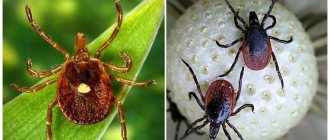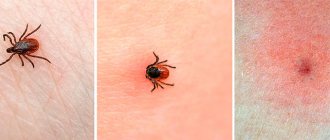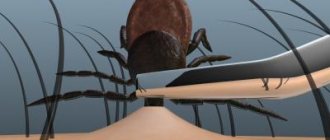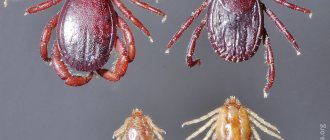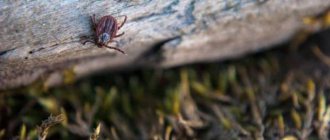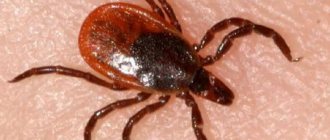Tick-borne Encephalitis. Consequences of a bite in humans
Walking through the forest is not always accompanied only by enjoying the surrounding nature, the aroma of trees, flowers and shrubs growing in this area. And also, besides birds and animals, there are a lot of insects that do not always please us.
Thus, a tick can cause a lot of trouble if it is a carrier of encephalitis, ranging from fever to death.
The encephalitis tick is the worst enemy of human health and life, this is its main danger. Namely bites, because through a bite this insect transmits diseases. But it is important to know that forest ticks can infect in this way , so when going into the forest, be careful!
The forest tick carries encephalitis and borreliosis, these are diseases that affect the nervous system and cause neurological and mental disorders, as well as death.
How to recognize an encephalitis tick in humans?
A person does not feel the bite itself, because the tick’s saliva secretes an anesthetic; it can only be noticed when examining the body. The encephalitis tick clings to the bottom of clothing and instinctively crawls up in order to settle down for lunch in a secluded place. This insect finds a place with thin skin near the vessels and bites into it. During the examination, it is important to carefully examine the head, armpits, area under the chest, and ears.
Tip: If the tick is located somewhere in the hair, then you may not notice it. Therefore, when examining your head, you need to straighten your hair, comb it, feeling the skin well. The bite site may look like a bump under the skin if the tick is very small. And after inspection, the clothes must be shaken outside, since the tick could not have penetrated the skin, but remained on the clothes.
After the bite, a slight discomfort is felt, and in its place redness or swelling appears.
Symptoms
It is important to know that the encephalitis tick is especially active in spring and summer. To find out if you have been bitten by this insect, remember the symptoms accompanying it. First, we propose to study the mechanism of spread of the disease. So, at first the signals of infection with the virus are invisible, a little later the lymph nodes are affected and the virus goes straight into the blood. Further, unfortunately, the encephalitis virus spreads further throughout the body, according to the blood circulation.
If the immune system is weak, symptoms will be noticeable already on the third day, but it has been noticed that symptoms appear ten days after the bite.
Treatment of encephalitis
Naturally, it is better to prevent a virus than to treat it. Therefore, it is worth getting an injection after being bitten by a tick. The injection includes ready-made antibodies against the virus. The composition of the drug contains blood from donors who were vaccinated against encephalitis.
There are medications, for example, interferon, ribonuclease. It should be borne in mind that not everyone who is bitten by an infected tick gets sick. Immunity is of great importance.
Treatment in the acute phase of the disease, when it is mild, requires bed rest. It is necessary to minimize the patient's movement and reduce painful stimuli to a minimum. Nutrition must also be correct. Your doctor will advise you on what to eat. The doctor will prescribe a suitable diet. In addition, the doctor will take into account the functions of the digestive tract when prescribing dietary nutrition. A viral disease can also occur due to insufficient amounts of vitamins. The doctor will also pay attention to this and, if necessary, prescribe vitamins B and C. When the disease is severe, there is a different approach to treatment.
Popular Symptoms of Shigellosis, prevention and treatment of infection
Patients are given gamma globulin serum to prevent brain swelling. When a person suffers from convulsions or epileptic symptoms, then Relanium should be prescribed. After recovery, massage and exercise therapy can be prescribed.
- Treatment is carried out in a hospital. Self-therapy may complicate treatment.
- Etiotropic treatment. During therapy, immunoglobulin is administered with a titer of at least 1:80.
- To avoid swelling of the organs and brain, dehydration treatment (Lasix) is carried out.
- Detoxification treatment. Any infection is accompanied by intoxication. A water-salt solution will help reduce poisoning.
- In particularly difficult cases, the child is connected to artificial ventilation.
- Symptomatic therapy consists of monitoring and normalizing temperature indicators, antibacterial therapy and antiviral substances.
Specificity and features of immunoglobulin
Immunoglobulin prescribed against tick-borne encephalitis is a mandatory preventive measure. The drug is prescribed immediately after an insect bite. The drug guarantees protection against the formation of the disease, and also eliminates the appearance of a severe form during infection.
The drug disrupts the cycle of viral formation in the first stages of infection. The effectiveness of the substance was confirmed when it was administered during the first days. When more than 4 days have passed after the bite, it is dangerous to administer the drug. Because during the latent period of virus development, it complicates the disease.
Signs of an encephalitis tick bite
- The temperature suddenly rises.
- Muscle spasms and severe pain.
- Nausea and vomiting, for no reason.
But insidiousness is not only in the presence of symptoms that can be attributed to poisoning or a cold. After about ten or seven days, everything goes away, and the condition of the bitten person noticeably improves. Many people attribute this to other reasons - a cold, poisoning, and so on, not realizing that these are the initial signs of an encephalitis tick bite.
However, after about ten minutes, the previously bitten person may feel:
- disturbances in the functioning of the nervous system;
- migraine;
- confused consciousness.
It is very difficult to predict with accuracy what will happen after a tick bite; everyone has a different body and a different amount of poison in the blood. But what will happen for sure is high temperatures, sometimes reaching 40 degrees. All this is accompanied by weakness and nausea, vomiting.
It is at this stage that the virus spreads everywhere, so you need to monitor the patient’s well-being; if a number of other symptoms are added to all of the above, it means that the disease has begun to take a severe form.
If the temperature subsides, it does not mean that the disease has stopped; perhaps it has turned into a meningeal form, with fever, fear of light and muscle spasms. In addition, the chance of developing paralysis of the limbs and death is not small.
Tick bite
Consequences of encephalitis
The consequences of viral encephalitis largely depend on factors such as:
- patient's age;
- his state of health at the time of infection;
- time elapsed from the onset of the disease to the start of treatment;
- form of the disease and severity.
Due to the damage to nerve cells in the brain, the consequences of tick-borne encephalitis can be compared with the consequences of other neurological diseases, such as stroke or head injuries. The majority of those who have recovered from the disease have impaired speech and cognitive functions.
Encephalitis
Among the most common consequences are:
- fatigue;
- headaches, migraine;
- muscle weakness;
- periodic loss of control over the body;
- numbness of some parts of the body (usually limbs);
- decreased reaction speed;
- speech disorders;
- weakening of memory;
- unstable emotional state;
- decreased visual and hearing acuity.
In the most severe cases, the consequences of encephalitis include:
- severe neuroses, depression;
- mental disorders;
- meningitis;
- visual or auditory hallucinations;
- symptoms of split consciousness;
- the spread of infection throughout the body, which causes disruption of the lungs, heart, kidneys, and gastrointestinal tract.
Depending on how severe the disease is and how pronounced the subsequent disorders are, recovery can take from several months to several years.
First steps when bitten by a tick
If you are bitten by a tick, then most likely it remains at the site of the bite and continues to suck blood, so, naturally, you need to pull it out!
To do this competently and professionally , go to a clinic or first aid station, where specially trained specialists will pull it out and perform all the necessary manipulations for your further safety. If you do not have the opportunity to immediately contact such specialists, remove it yourself.
- To remove a tick at home, you need to protect your fingers with a gauze bandage, without making much effort, shake the insect from side to side and twist it counterclockwise.
- Do not use sharp tools or pull it out if you feel resistance, as it will release more poison into your body! This also applies to removing a tick with oil; under no circumstances should you apply vinegar and oil to the area!
- After removing the tick, lubricate the affected area with alcohol.
You may also find information on how to remove a tick at home useful, read on our website.
It is important to correctly remove the insect from the wound and prevent severe poisoning from the poison and an increase in its amount in the blood. In addition, the head should not remain in the wound. When you have pulled out the tick, take it to the hospital for examination, in case it is a carrier of encephalitis.
If the wound turns pink, and after some time this stain has subsided, the danger has passed, and the tick was removed correctly and safely.
Mite
Treatment of a person bitten by an encephalitis tick
First aid should be provided at the moment a tick is discovered. To do this, you need to extract it using technology. Only its correct and complete extraction guarantees the complete exit of the bloodsucker. If he leaves any part of his body in the wound, in addition to infection, infection will also occur. After removal, be sure to disinfect the wound and wash your hands thoroughly.
- The extracted individual must be placed in a test tube and sent for analysis as soon as possible. Subsequent measures are carried out after examination by a doctor.
- The virus in the body can be detected directly in a medical facility. To do this, fluid is taken from the spinal cord, after which a test is carried out to determine antibodies.
- If the laboratory confirms the virus, the bitten person must immediately be administered immunoglobulin, a special anti-bite serum, after which iodantiprine preparations are prescribed.
Basically, treatment with a correctly prescribed protocol is aimed at relieving symptoms and mitigating the patient’s condition. Treatment is long-term, complex, the following drugs are usually prescribed:
Clinical treatment can be emergency or planned.
- Emergency treatment is the treatment of an identified illness. In this case, drugs that stimulate the immune system are administered. The first time the standard rate is introduced, the second time it is doubled. Repeated administration is carried out 10 days after the first.
- Preventative treatment is called planned. This is a vaccination that is administered twice. Repeated vaccination is mandatory after three years.
Where to contact
If you suddenly notice signs of an encephalitis tick bite in a person or symptoms of an encephalitis tick bite in a dog, immediately contact a veterinarian or regular clinic. There you can get professional help and remove the insect using a safe method.
In addition, this way you will be sure that everything was done correctly and there is no threat of the virus spreading. In specialized institutions, the ticks are sent for examination, where, with the help of special tests, they will find out whether it was a carrier of encephalitis.
What could be the consequences?
It should be understood that not all individuals pose a danger, but only those that are carriers of the infection. If the bite was caused by a non-infected parasite, then all that should be done is to properly remove it from the body.
But there are individuals that are really very dangerous, because when bitten they can transmit pathogens of the following diseases:
- Encephalitis. If the virus enters the human body, it affects the brain and central nervous system. Without proper treatment, the disease is very difficult to tolerate and causes serious complications. May be fatal.
- Lyme disease. In this case, infection occurs with bacteria that belong to the Borrelia species. This disease is quite insidious, since it can be completely asymptomatic for a long time, but at the same time give complications, affecting the joints, nervous system, and cardiovascular system. Symptoms also manifest differently for everyone and sometimes it is very difficult for a doctor to diagnose the disease.
- Monocytic ehrlichiosis. Causes neurological complications. Respiratory diseases and general intoxication develop.
- Granulocytic anaplasmosis. Infection occurs with bacteria, which, as they develop in the body, can lead to meningoencephalitis and kidney damage.
Precautionary measures
The very first rule among all precautions is to get vaccinated against encephalitis! Having protected yourself with the vaccine, you can safely wander through the forest at any time. It is especially important to take this rule into account during periods of particular activity of ticks - in spring and summer. The news often reports regions with an increased incidence of encephalitis due to tick bites. Therefore, if you live in one of the regions with this problem, get vaccinated!
A few more rules:
- wear light-colored clothing so that the insect is visible;
- cover your head with a scarf, hat or cap;
- keep ticks away from your body, tuck your pants into your socks and wear rubber boots on top;
- choose long sleeve shirts or turtlenecks;
- apply tick repellent;
- carefully examine yourself and the animals.
Consequences
The mite is an insidious insect. Walking through the forest, you don’t think about such a danger as encephalitis. But the consequences are more than serious. At first it is fever, chills, muscle spasms, nausea. But it is not always limited to this; paralysis of the limbs, hallucinations and even death are possible.
0
Author of the publication
offline 2 years
Nika
7
I am interested in hiking and traveling, photography and videography. I have been going hiking since childhood. The whole family went and went - sometimes to the sea, then to the river, to the lake, to the forest. There was a time when we spent a whole month in the forest. We lived in tents and cooked over fires. This is probably why I am still drawn to the forest and, in general, to nature. I travel regularly. About three trips a year for 10-15 days and many 2 and 3 day hikes.
Comments: 0Publications: 668Registration: 10/23/2018
Nika Medical assistance
Preventive actions
The consequences of a bite were described above; in order not to suffer from them, it is enough to follow simple conditions to protect yourself. It is especially dangerous to get a bite from a parasite between May and July, because during this period the ticks wake up and can be especially poisonous. In order to protect yourself from tick bites, it is necessary to undergo preventive vaccination before the start of the warm season. You should think about carrying out a course of vaccinations at the beginning of February, since they are given in three stages, observing a certain interval.
You can get vaccinated for free, but if you have a choice, it is better to give preference to an imported drug. If it is too late to get vaccinated, then when going outdoors you need to dress well, your neck, head, legs and arms should be covered. When returning home, you need to carefully examine your clothes and body.
You should take anti-tick spray with you on your hike. This small insect can jump onto a person’s body by jumping off a dog after a walk, so it is necessary to inspect the pet every time, even if it was constantly within the city.





